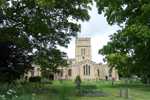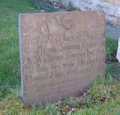For this church:    |
Langar St AndrewChurchyard
Smaller AreaThe smaller area contains the memorial stones to many well-known figures in the history of Langar and its surrounding region. These include the following: John Chaworth MustersA slate slab affixed to the church wall which reads:
(The main memorials to the Chaworth Musters family can be seen in the north transept). Penn Curzon SherbrookeCaptain of the South Notts Hussars Yeomanry and for 17 years Master of the Sinnington Hounds. William ButlerYounger brother of Samuel Butler the famous author, painter, musician and philosopher. Thomas and Annie BayleyThomas Bayley was a wealthy coal owner and liberal MP for Chesterfield. His wife Annie was the daughter of composer Henry Farmer. She bought Langar Hall in 1860. The stained glass window in the west wall of the church is also in their memory, and was donated by their son, Henry Dennis Readett-Bayley in 1916. 
Percy Lambe HuskinsonMarried Muriel, daughter of Annie Bayley who carried on living at Langar Hall. Geoffrey Neville Bayley HuskinsonInherited Langar Hall on the death of Muriel Bayley in 1933. Geoffrey was a former president of the Notts County Cricket Club and played rugby for England. Reverend Edward GregoryReverend Edward Gregory discovered comet 1793 Gregory-Méchain (C/1793 A1, 1792 II) in the evening of January 8, 1793, when observing Venus and measuring its distance from Iota Aquarii; he traced this comet until January 12. This was independently found by Pierre Méchain on January 10; the comet was observed by a number of astronomers until February 14 of that year. Main AreaIn the main churchyard can also be seen the memorial stones to: Major General Sir Miles Graham K.B.E., C.B., M.C.Sir Miles gained his first medal, the Military Cross, during his service with the Life Guards during the First World War. When the Second World War commenced, he formed the First Cavalry Division and was posted to Palestine. He was later appointed Chief Administrative Officer to Field Marshall Montgomery and saw service throughout the campaigns in Egypt, Cyrenaica, Tripolitania, Sicily, Italy and the Normandy landings. Sir Miles and Lady Graham became the owners of Wiverton Hall at the end of the war. The stone is a plain slab, laid horizontally, with simple inscription reading:
William GrettonVillage Blacksmith. His name can be seen on the hinges of the main church door. William Simon
|







